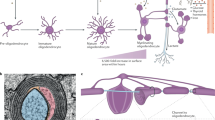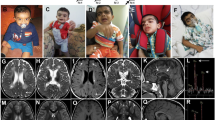Abstract
T2 hyperintensity of brain white matter lesions detected by magnetic resonance imaging (MRI) are characteristic of a heterogeneous group of diseases. Persistent T2 high intensity in combination with T1 iso- or high intensity of white matter in infants indicates a lack of normal myelination, that is, hypomyelination. However, the precise diagnosis of hypomyelinating leukodystrophy based solely on MRI findings can be difficult, especially in the early stage of the disease. We studied 26 patients who were diagnosed with hypomyelinating leukodystrophy according to MRI findings and clinical features to uncover their genetic etiology through chromosomal analyses, targeted gene analyses, and an array comparative genomic hybridization (aCGH) assay. Then, for the 17 patients with unexplained hypomyelination by traditional analyses, whole-exome sequencing (WES) was performed. The presumptive diagnoses were confirmed in 58 % of the enrolled patients (15/26) and involved 9 different genetic backgrounds. The most frequent backgrounds were 18q deletion syndrome and Pelizaeus–Merzbacher disease, with an incidence of 12 % (3/26) for both. The diagnostic rate of chromosomal analyses, targeted gene analyses, and aCGH was 31 % (8/26), and one patient was clinically diagnosed with Cockayne syndrome. Using WES, the following causative genes of hypomyelination were identified in six individuals (35 %, 6/17): TUBB4A, POLR3B, KCNT1, and MCOLN1, and some of those genes were pathogenic for not only hypomyelination but also dysmyelination or delayed myelination. Our findings suggested heterogeneous genetic backgrounds in patients with persistent white matter lesions. These data also indicate that WES may be a rapid and useful tool for identifying the underlying genetic causes of undiagnosed leukodystrophies.


Similar content being viewed by others
References
Abe J, Nakamura K, Nishikomori R et al (2014) A nationwide survey of Aicardi-Goutières syndrome patients identifies a strong association between dominant TREX1 mutations and chilblain lesions: Japanese cohort study. Rheumatology (Oxford) 53:448–458. doi:10.1093/rheumatology/ket372
Adzhubei IA, Schmidt S, Peshkin L et al (2010) A method and server for predicting damaging missense mutations. Nat Methods 7:248–249. doi:10.1038/nmeth0410-248
Altarescu G, Sun M, Moore DF et al (2002) The neurogenetics of mucolipidosis type IV. Neurology 59:306–313
Barcia G, Fleming MR, Deligniere A et al (2012) De novo gain-of-function KCNT1 channel mutations cause malignant migrating partial seizures of infancy. Nat Genet 44:1255–1259. doi:10.1038/ng.2441
Barkovich AJ (2000) Concepts of myelin and myelination in neuroradiology. AJNR Am J Neuroradiol 21:1099–1109
Berger J, Moser HW, Forss-Petter S (2001) Leukodystrophies: recent developments in genetics, molecular biology, pathogenesis and treatment. Curr Opin Neurol 14:305–312
Cooper GM, Goode DL, Ng SB et al (2010) Single-nucleotide evolutionary constraint scores highlight disease-causing mutations. Nat Methods 7:250–251. doi:10.1038/nmeth0410-250
Frei KP, Patronas NJ, Crutchfield KE et al (1998) Mucolipidosis type IV: characteristic MRI findings. Neurology 51:565–569
Hamilton EM, Polder E, Vanderver A et al (2014) Hypomyelination with atrophy of the basal ganglia and cerebellum: further delineation of the phenotype and genotype–phenotype correlation. Brain 137:1921–1930. doi:10.1093/brain/awu110
Harting I, Seitz A, Rating D et al (2009) Abnormal myelination in Angelman syndrome. Eur J Paediatr Neurol 13:271–276. doi:10.1016/j.ejpn.2008.04.005
Hersheson J, Mencacci NE, Davis M et al (2013) Mutations in the autoregulatory domain of β-tubulin 4a cause hereditary dystonia. Ann Neurol 73:546–553. doi:10.1002/ana.23832
Ishii A, Shioda M, Okumura A et al (2013) A recurrent KCNT1 mutation in two sporadic cases with malignant migrating partial seizures in infancy. Gene 531:467–471. doi:10.1016/j.gene.2013.08.096
Kadalayil L, Rafiq S, Rose-Zerilli MJJ et al (2015) Exome sequence read depth methods for identifying copy number changes. Brief Bioinform 16:380–392. doi:10.1093/bib/bbu027
Kaye EM (2001) Update on genetic disorders affecting white matter. Pediatr Neurol 24:11–24. doi:10.1016/S0887-8994(00)00232-0
Kohlschütter A, Eichler F (2011) Childhood leukodystrophies: a clinical perspective. Expert Rev Neurother 11:1485–1496. doi:10.1586/ern.11.135
Loevner LA, Shapiro RM, Grossman RI et al (1996) White matter changes associated with deletions of the long arm of chromosome 18 (18q − syndrome): a dysmyelinating disorder? AJNR Am J Neuroradiol 17:1843–1848
Miyatake S, Osaka H, Shiina M et al (2014) Expanding the phenotypic spectrum of TUBB4A-associated hypomyelinating leukoencephalopathies. Neurology 82:2230–2237. doi:10.1212/WNL.0000000000000535
Ng PC, Henikoff S (2003) SIFT: predicting amino acid changes that affect protein function. Nucleic Acids Res 31:3812–3814
Numata Y, Gotoh L, Iwaki A et al (2014) Epidemiological, clinical, and genetic landscapes of hypomyelinating leukodystrophies. J Neurol 261:752–758. doi:10.1007/s00415-014-7263-5
Parikh S, Bernard G, Leventer RJ et al (2015) A clinical approach to the diagnosis of patients with leukodystrophies and genetic leukoencephelopathies. Mol Genet Metab 114:501–515. doi:10.1016/j.ymgme.2014.12.434
Peters SU, Kaufmann WE, Bacino CA et al (2011) Alterations in white matter pathways in Angelman syndrome. Dev Med Child Neurol 53:361–367. doi:10.1111/j.1469-8749.2010.03838.x
Pouwels PJW, Vanderver A, Bernard G et al (2014) Hypomyelinating leukodystrophies: translational research progress and prospects. Ann Neurol 76:5–19. doi:10.1002/ana.24194
Richards S, Aziz N, Bale S et al (2015) Standards and guidelines for the interpretation of sequence variants: a joint consensus recommendation of the American College of Medical Genetics and Genomics and the Association for Molecular Pathology. Genet Med 17:405–423. doi:10.1038/gim.2015.30
Saitsu H, Osaka H, Sasaki M et al (2011) Mutations in POLR3A and POLR3B encoding RNA polymerase III subunits cause an autosomal-recessive hypomyelinating leukoencephalopathy. Am J Hum Genet 89:644–651. doi:10.1016/j.ajhg.2011.10.003
Schiffmann R, van der Knaap MS (2009) Invited article: an MRI-based approach to the diagnosis of white matter disorders. Neurology 72:750–759. doi:10.1212/01.wnl.0000343049.00540.c8
Schwarz JM, Cooper DN, Schuelke M, Seelow D (2014) MutationTaster2: mutation prediction for the deep-sequencing age. Nat Methods 11:361–362. doi:10.1038/nmeth.2890
Shiihara T, Watanabe M, Moriyama K et al (2014) A novel PLP1 frameshift mutation causing a milder form of Pelizaeus-Merzbacher disease. Brain Dev 37:455–458. doi:10.1016/j.braindev.2014.06.011
Simons C, Wolf NI, McNeil N et al (2013) A de novo mutation in the β-tubulin gene TUBB4A results in the leukoencephalopathy hypomyelination with atrophy of the basal ganglia and cerebellum. Am J Hum Genet 92:767–773. doi:10.1016/j.ajhg.2013.03.018
Steenweg ME, Vanderver A, Blaser S et al (2010) Magnetic resonance imaging pattern recognition in hypomyelinating disorders. Brain 133:2971–2982. doi:10.1093/brain/awq257
Sugita K, Suzuki N, Kojima T et al (1987) Cockayne syndrome with delayed recovery of RNA synthesis after ultraviolet irradiation but normal ultraviolet survival. Pediatr Res 21:34–37. doi:10.1203/00006450-198701000-00009
Tada H, Takanashi J (2014) MR spectroscopy in 18q(−) syndrome suggesting other than hypomyelination. Brain Dev 36:57–60. doi:10.1016/j.braindev.2012.12.003
Tan R, Wang Y, Kleinstein SE et al (2014) An evaluation of copy number variation detection tools from whole-exome sequencing data. Hum Mutat 35:899–907. doi:10.1002/humu.22537
Tétreault M, Choquet K, Orcesi S et al (2011) Recessive mutations in POLR3B, encoding the second largest subunit of Pol III, cause a rare hypomyelinating leukodystrophy. Am J Hum Genet 89:652–655. doi:10.1016/j.ajhg.2011.10.006
Vanderver A, Simons C, Schmidt JL et al (2014) Identification of a novel de novo p.Phe932Ile KCNT1 mutation in a patient with leukoencephalopathy and severe epilepsy. Pediatr Neurol 50:112–114. doi:10.1016/j.pediatrneurol.2013.06.024
Vanderver A, Prust M, Tonduti D et al (2015) Case definition and classification of leukodystrophies and leukoencephalopathies. Mol Genet Metab 114:494–500. doi:10.1016/j.ymgme.2015.01.006
Wakabayashi K, Gustafson AM, Sidransky E, Goldin E (2011) Mucolipidosis type IV: an update. Mol Genet Metab 104:206–213. doi:10.1016/j.ymgme.2011.06.006
Wang K, Li M, Hakonarson H (2010) ANNOVAR: functional annotation of genetic variants from high-throughput sequencing data. Nucleic Acids Res 38:e164. doi:10.1093/nar/gkq603
Acknowledgments
We thank all of the participants for their cooperation in this research and Ms. Y. Chiba and Ms. K. Ito for their technical assistance. We also acknowledge the support of the Biomedical Research Core of Tohoku University Graduate School of Medicine. This study was supported by JSPS KAKENHI Grant Number 25461533.
Author information
Authors and Affiliations
Corresponding author
Ethics declarations
Informed consent
Informed consent was obtained from all individual participants included in the study.
Funding
This study was funded by JSPS KAKENHI Grant Number 25461533.
Conflict of interest
The authors have no conflicts of interest to declare.
Electronic supplementary material
Below is the link to the electronic supplementary material.
Rights and permissions
About this article
Cite this article
Arai-Ichinoi, N., Uematsu, M., Sato, R. et al. Genetic heterogeneity in 26 infants with a hypomyelinating leukodystrophy. Hum Genet 135, 89–98 (2016). https://doi.org/10.1007/s00439-015-1617-7
Received:
Accepted:
Published:
Issue Date:
DOI: https://doi.org/10.1007/s00439-015-1617-7




